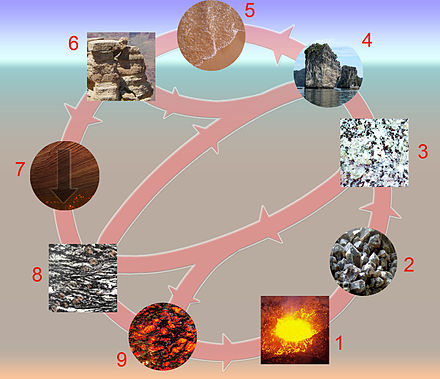Cycle of rocks
Under the cycle of rocks , in certain contexts, as Recycling referred, refers to the Geosciences those cycle , during which rocks are formed, can be altered and finally destroyed in various ways. Such a cycle usually lasts around 200 million years.
Basics
The different rock types and individual rocks are transformed into one another through geodynamically mediated processes ( erosion , sedimentation , rock metamorphosis , etc.).
As geological periods elapse, large amounts of rock weather due to the influence of wind , water , ice , daily or seasonal temperature differences or chemical weathering processes. These weathering products can meanwhile form soils , go into solution or suspension in water , are transported as dust by the wind, and the like. At some point, however, usually after a geologically short to very short period of time, they deposit in a stable manner (which can also include the precipitation of previously chemically weathered inorganic substances transported in solution), petrify (“petrify”) and form sedimentary rocks . These are transported to deeper regions of the earth's crust, may undergo a transformation ( metamorphosis ) or are even sunk so deep that they melt and become magma . After sinking, a changed sedimentary rock (possibly through metamorphosis) can be raised by tectonic uplift of the crustal clod in which it is located and exposed again through erosion of the overlying rocks, so that the cycle begins again. If there has been a meltdown in the depths, the magma can emerge as lava on the surface of the earth and solidify there to form volcanic rock , which is then exposed to weathering again there.
The true duration of the period cycle depends on the geological - tectonic structure of the region, the density of the rock packages involved and the moving forces. The latter come from erosion , mountain formation , tectonic faults and volcanism , and thus ultimately from plate tectonics .
Certain minerals are much more resistant to weathering than others, which means that zirconia (which are also particularly suitable for radiometric dating using the uranium-lead method ) have been shown to be very old, while the igneous rock in which they are Zircons were once crystallized, but have long since been weathered. The oldest mineral grain ever dated is a 4.4 billion year old zircon from the Jack Hills in Australia. It is contained in a sedimentary rock that is still very old, but was deposited well after the zircon crystallized, whereas its original igneous host rock has disappeared without a trace. From a geological point of view, this mineral grain was formed relatively shortly after the formation of the first solid earth crust.
Scheme of the rock cycle
The following diagram shows how the representatives of the three rock classes that occur on earth are transformed into one another:
|
The rock classes are:
The processes are:
|
This scheme connects different geological topics (especially the rock cycle) and places them in a geographical context:
See also
- List of rocks
- Earth's crust , earth's mantle
- Orogeny , sedimentation
- Geosyncline
- Tectonics , continental drift , deep sea trenches
- Carbonate-silicate cycle , a sub -cycle that also affects the hydrosphere and atmosphere
literature
- Klaus-Henning Georgi: The cycle of rocks. An introduction to geology (= rororo 7758 rororo non-fiction book ). 44. – 53. Thousand. Rowohlt, Reinbek near Hamburg 1983, ISBN 3-499-17758-7 .
- John Grotzinger, Tom Jordan: Press / Siever General Geology. 7th edition. German translation: Volker Schweizer. Springer Spectrum, 2017, ISBN 978-3-662-48341-1 , pp. 77 f., 114 f, 430.


